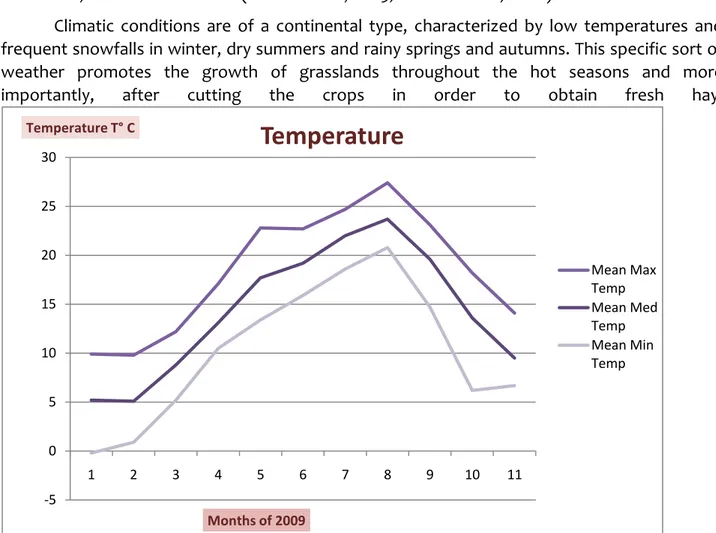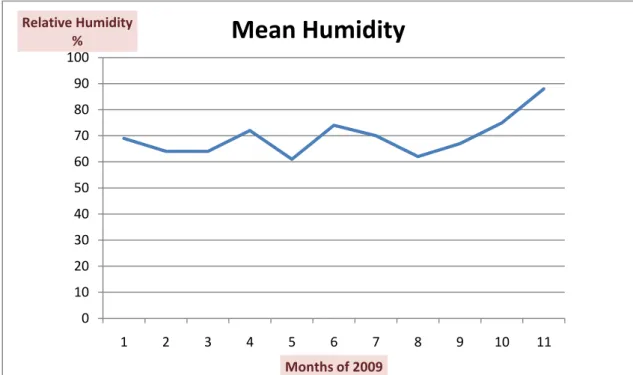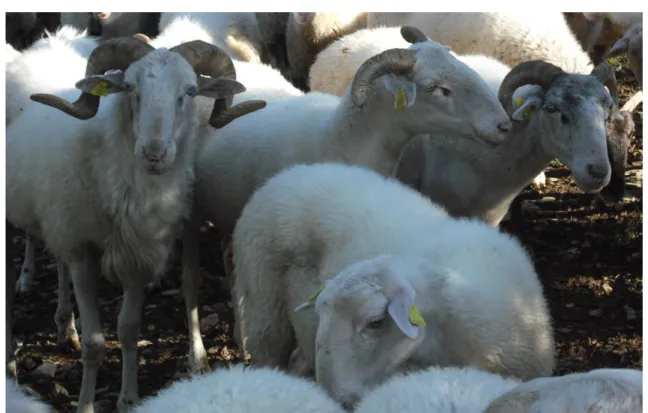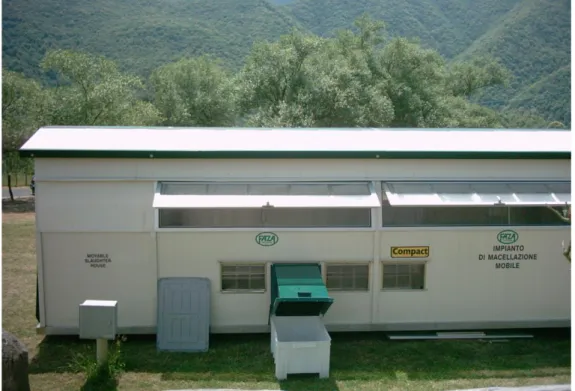Chapter I: Zeri and Zerasca sheep
Section 1. The territory of Zeri
The township of Zeri is located at the very tip of the Lunigiana, which covers the area from the Apennines to the Magra river, situated in the north-east part of Tuscany in the province of Massa Carrara. It is positioned between three Italian regions: Tuscany, Liguria and Emilia Romagna, on the ridge of the mountains. The municipality of Zeri covers an area of 73,59 squared kilometers characterized by a demographic density of almost 18 inhabitants per km². The inferior part of the valley is left unpopulated and abandoned, while the higher areas between 600 and 1400 meters above sea level (m a.s.l.) is where reside 1314 citizens of 682 families (ISR, 2005). The municipality of Zeri covers four valleys: the valley of Zeri, Adelano, Rossano and Codolo.
The natural woody vegetation mainly includes oak, chestnut, hazel, alder and beech trees in the lower areas (within 800 m a.s.l.), whereas the higher strips of land offer the majority of the meadows and pastures used for sheep grazing which are situated within 1200 m a.s.l. The meadows mainly consist of true grasses, forage legumes and shrubs such as ash, hornbeam, hazelnut and acacia (Goracci et al., 2005; Perrucci et al., 2006).
Climatic conditions are of a continental type, characterized by low temperatures and frequent snowfalls in winter, dry summers and rainy springs and autumns. This specific sort of weather promotes the growth of grasslands throughout the hot seasons and more importantly, after cutting the crops in order to obtain fresh hay.
Figure 1. Average monthly temperatures monitored at Pontremoli weather station. Numbers 1-11 correspond to months of the year 2009. (Source ARSIAMeteo, 2009).
-5 0 5 10 15 20 25 30 1 2 3 4 5 6 7 8 9 10 11 Temperature T° C Months of 2009
Temperature
Mean Max Temp Mean Med Temp Mean Min TempFigure 2. Monthly relative humidity in % monitored at Pontremoli weather station. (Source: ARSIAMeteo, 2009).
Figure 3. Mean monthly precipitation in mm monitored at Pontremoli weather station. (Source: ARSIAMeteo, 2009).
The inconsistency of this climate suggests the great variability amongst the grazing land productions which are fundamental for the pasture management of sheep which is why the breeders send their flocks to high altitudes during the winter and summer (Goracci et al., 2005). Normally, the herd performs a vertical transhumance in the beginning of spring, aiming at utilizing the newly sprung grass of the higher lands and before the end of autumn they start to descend towards the barns, at a maximum altitude of 800 m.a.s.l. (Verità et al., 2006).
0 10 20 30 40 50 60 70 80 90 100 1 2 3 4 5 6 7 8 9 10 11 Relative Humidity % Months of 2009
Mean Humidity
0 50 100 150 200 250 300 1 2 3 4 5 6 7 8 9 10 11 Precipitation mm Months of 2009Mean Precipitation
A total of 192 farms and nearly 300 agricultural workers (22.8% of the population) are responsible for the animal husbandry and agriculture in this territory (Goracci et al., 2005) involving all livestock animals and the cultivation of cereals, fruit and vegetables. The sheep farms are all managed by local families and especially by young women.
Sheep husbandry is currently predominant in this area thanks to the great availability of pastures which undoubtedly has given space to the semi-extensive manner of raising and breeding these animals. Therefore, animals’ nutrition depends mostly on grazing natural pastures, infact the herd is assured little or no nutritional supplementation.
Section 2. A native sheep breed-Zerasca
The Zerasca sheep breed is indigenous to the Lunigiana area and its first documentation dates back to the 19th Century when an agronomist named Antonelli came across this indigenous breed, renowned for its excellent lamb meat. The creation of hybrids has been attempted in the past few decades aiming at increasing quantitatively the milk production however causing negative repercussions forcing these cross-breedings to be abandoned. Nowadays, the individuals of this breed are rather homogeneous among themselves (Verità et
al., 2006).
Zerasca sheep husbandry is mostly concentrated in the township of Zeri counting a total number of individuals around 2050 in the year 2006, with a mean of 58 being raised on each farm. On average, each farm disposes of 20 ha for the pasturage of these animals, underlining the close connection to the territory.
The Zeri lamb is a sturdy animal, medium-large in size and covered by a white fleece. Average live weight in rams is around 80kg whereas the ewes weigh 55kg at the most. All male and most female individuals are distinguished by the presence of horns. The ewes present two important birth periods throughout the year, in springtime and in autumn, showing a twinning rate of 30-60% (Verità et al., 2006).
Figure 4. Photograph of a few examples of Zeri sheep.
This breed is reared under an extensive grazing management system throughout the entire year, except for when the colder seasons arrive and the animals are kept on pastures near the barns to facilitate supplementation of hay and maize kernels.
Animal morphology: Size: medium-large.
Fleece: white and not present on lower abdomen and the lower ends of the limbs.
Skin and colour: pink-couloured skin, thin and elastic; limbs and head are seldom pigmentated by grey, pinkish or even brown colours.
Head: proportioned and light, showing a linear profile in females; ears are of medium-length pointing horizontally, wide nostrils and loose lips which indicate good grazing skills.
Horns: always present in rams, usually large forming a spiral which ends towards the anterior; not so large in females when present.
Neck: medium-length, well attached in rams.
Thorax and abdomen: relatively long, robust skeleton with thin bone diameters, straight thoracic/lumbar region, shoulders well attached, wider chest in rams then in ewes; thorax showing a large transversal diameter, long loins well attached to the anterior and to the posterior, broad posterior angle of the rump which shows well developed longitudinal and transversal diameters, vast abdomen.
Mammary gland: broad but with small nipples and a thick skin.
Limbs: relatively long, robust with a regular gait, toenails are white and sturdy. Medium weight of rams: 80kg.
Medium weight of ewes: 55kg. (Source: Verità et al., 2006).
The Zerasca is principally raised for its characteristic lamb meat given that lambs at 70 days of age reach a live weight of around 23 kg. This is also justified by the high protein concentration found in the ewes’ milk, along with their notorious capacity of exploiting the earth’s nutritional resources (Verità et al., 2006). The dressing percentage has been described as the expression between live and carcass weight (Jacobson et al., 2009), and it amounts to 55 percent in the case of the Zerasca lambs. They are used to produce a savory, tasty and tender meat but once they are sold, the remaining milk is collected by the farmers to be turned into traditional cheeses, not yet destined to commercial purposes.
In the year 2001, a Consortium for the Valorization and Safeguarding of the Zerasca sheep and lambs was established including 18 farms and it has had an important role in trying to restore ancient production techniques (Goracci et al., 2005).
“Zeri lamb” is currently trying to obtain the official attribution of the European “IGP” (Indicazione Geografica Protetta) registration, after acknowledgement of this product as fully entitled and in accordance with the specific requirements. The “IGP” registration would provide a further guarantee in order to defend breeders who have submitted themselves to unfair competition for decades, during which their merchandise was exposed on national markets alongside products of lower quality and yet declared as having the same origin (“Il Tirreno”, November 14th 2009).
The farmers who adhere to the “disciplinary” with specifications regarding the Zeri lamb production are licensed to place the registered brand name. Today, the Zeri lamb has a considerable economic impact on the territory, ensuring increasing profits for shepherds. Infact, the local farmer community was able to obtain a positive outcome in demanding the construction of a small local abattoir (see Figure 5) reserved for the slaughter of the local livestock. This ensures an amelioration of the transport conditions of animals who in the past, suffered from shaky trips to the slaughterhouse, located more than 20 km away.
Zerasca sheep present a white fleece which is sheared and used to manufacture another typical product associated with this sheep rearing which is the “mezzalana”, a mixture of wool and hemp used for the fabrication of socks, sweaters, carpets, mattresses, pillows and traditional long skirts (Perrucci et al., 2006).
Section 3. Social and economic importance of the Zerasca breed
The aspects mentioned above demonstrate the peculiarity of this indigenous breed that has settled onto these marginal territories and has developed the capability to fully benefit from them. Its social and economic importance for these farmers explains the continuous need to maintain a sustainable and profitable breeding management.
Zeri contains 1314 inhabitants of which nearly 300 are agricultural workers, meaning that 22.8% of the population is engaged in animal husbandry and agricultural labour. Surveys carried out in this area have provided interesting data relative to the entrepreneurship aspects of this business. Results have indicated that 54% of the farms are run by women having an average age of 49 years, with a maximum of 55 and a minimum of 24. In addition, 45% of women raise other species as well as sheep whereas this occurs in only 23% of farms managed by men. In 15% of farms run by women, cheese is obtained as a secondary product whereas most of the farms seem to have ignored this additional benefit. The manufacturing of sheep wool “mezzalana” represents a further way of enhancing the valorization of Zerasca sheep-derived creations and is performed in 20% of women’s farms, as opposed to the 12% of farms led by male flock holders.
The Zerasca sheep population adds up to 2143 individuals, raised in 37 farms, 92% of which contains pure-breeds (Goracci et al., 2005). This breed has demonstrated a remarkable ability to tolerate harsh climatic conditions (Verità et al., 2006).
Recently, there have been several massacres of lambs due to the presence of a pack of wolves which attack the smaller animals even during daylight. These wolves live in the nearby woods and don’t seem to be intimidated by the presence of humans, nor are they stopped by the newly built fences. Frightened and worried breeders and inhabitants have raised the alarm causing the Coldiretti (largest organization of agricultural workers on national grounds) to declare the state of emergency. It has been estimated that each farm has suffered great losses of lambs, quantified up to nearly 50% of the total stocks in some cases. In one whole year, farms have lost a total of 15-20 sheep, which is not to be underestimated considering that the average number of sheep in a flock is around 60-70, meaning that some farmers have lost 20-30% of their income (“Il Tirreno”, November 14th 2009).
The agricultural activity settled in this area strives to succeed in a market sector which is evolving at a faster speed and is becoming ever more industrialized. Economical and social aspects of these farms cannot always appeal to the expectations of a model urban society which is highly attractive to the younger range of the population. The consequence of this tendency is an increasing depopulation which inevitably leads to demographic changes, where so much needs to be done in order to sustain the remaining workers and their activities. The safeguard of this rural land, its population and the local produce must be maintained and the
women of this township have indeed demonstrated their particular inclination and devotion towards this aspiration (Benvenuti et al., 2005).
The Zerasca sheep’s meat has revealed a unique organoleptic characteristics regarding tenderness, tastiness and aroma. As a result, it has earned the hallmark of Slow Food Presidia, a record of hundreds of traditional products from all over the world, listed for documentation, guarantee and advertising purpose. Today, Zeri lamb has a considerable economic impact on the territory, ensuring increasing profits for shepherds (Goracci et al., 2005).



